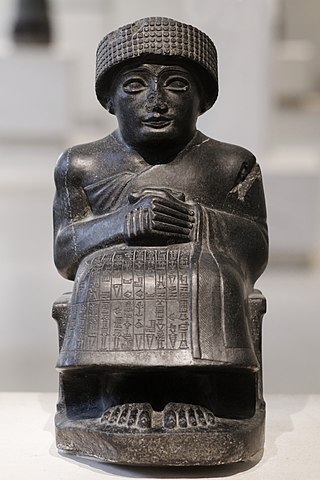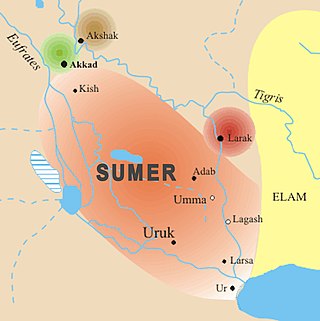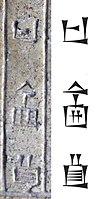
The history of Sumer spans the 5th to 3rd millennia BCE in southern Mesopotamia, and is taken to include the prehistoric Ubaid and Uruk periods. Sumer was the region's earliest known civilization and ended with the downfall of the Third Dynasty of Ur around 2004 BCE. It was followed by a transitional period of Amorite states before the rise of Babylonia in the 18th century BCE.

Umma (Sumerian: 𒄑𒆵𒆠ummaKI; in modern Dhi Qar Province in Iraq, was an ancient city in Sumer. There is some scholarly debate about the Sumerian and Akkadian names for this site. Traditionally, Umma was identified with Tell Jokha. More recently it has been suggested that it was located at Umm al-Aqarib, less than 7 km to its northwest or was even the name of both cities. One or both were the leading city of the Early Dynastic kingdom of Gišša, with the most recent excavators putting forth that Umm al-Aqarib was prominent in EDIII but Jokha rose to preeminence later. The town of KI.AN was also nearby. KI.AN, which was destroyed by Rimush, a ruler of the Akkadian Empire. There are known to have been six gods of KI.AN including Gula KI.AN and Sara KI.AN.

The Gutian dynasty was a line of kings, originating among the Gutian people. Originally thought to be a horde that swept in and brought down Akkadian and Sumerian rule in Mesopotamia, the Gutians are now known to have been in the area for at least a century by then. By the end of the Akkadian period, the Sumerian city of Adab was occupied by the Gutians, who made it their capital. The Gutian Dynasty came to power in Mesopotamia near the end of the 3rd millennium BC, after the decline and fall of the Akkadian Empire. How long Gutian kings held rulership over Mesopotamia is uncertain, with estimates ranging from a few years up to a century. The end of the Gutian dynasty is marked by the accession of Uruk ruler Utu-hengal, marking the short-lived "Fifth dynasty of Uruk", followed by Ur ruler Ur-Nammu, founder of the Third Dynasty of Ur.

Tirigan was the 19th and last Gutian ruler in Sumer mentioned on the "Sumerian King List" (SKL). According to the SKL: Tirigan was the successor of Si'um. Tirigan ruled for 40 days before being defeated by Utu-hengal of Uruk, c. 2050 BC.
Ibate was the 8th Gutian ruler of the Gutian Dynasty of Sumer mentioned on the Sumerian King List (SKL).

The Guti, also known by the derived exonyms Gutians or Guteans, were a people of the ancient Near East. Their homeland was known as Gutium.

Gutian is an extinct unclassified language that was spoken by the Gutian people, who briefly ruled over Sumer as the Gutian dynasty in the 22nd century BCE. The Gutians lived in the territory between the Zagros Mountains and the Tigris. Nothing is known about the language except its existence and a list of names of Gutian rulers in the Sumerian King List, which may reflect elements of the language.
Yarlagab was the 7th Gutian ruler of the Gutian Dynasty of Sumer mentioned on the "Sumerian King List" (SKL). According to the SKL: Yarlagab was the successor of Igeshaush. Ibate then succeeded Yarlagab, likewise according to the SKL.
Yarlaganda was the 17th Gutian ruler of the Gutian Dynasty of Sumer mentioned on the "Sumerian King List" (SKL). According to the SKL: Yarlaganda was the successor of Puzur-Suen. Si'um then succeeded Yarlaganda.
Yarla or Yarlangab was the 9th Gutian ruler of the Gutian Dynasty of Sumer mentioned on the "Sumerian King List" (SKL). Yarla was the successor of Ibate. Kurum then succeeded Yarla.
Hablum was the 15th Gutian ruler of the Gutian Dynasty of Sumer mentioned on the "Sumerian King List" (SKL). According to the SKL: Hablum was the successor of Ibranum. Puzur-Suen then succeeded Hablum
Ibranum was the 14th Gutian ruler of the Gutian Dynasty of Sumer mentioned on the "Sumerian King List" (SKL). According to the SKL: Ibranum was the successor of Irarum. Hablum then succeeded Ibranum
Irarum was the 13th Gutian ruler of the Gutian Dynasty of Sumer mentioned on the "Sumerian King List" (SKL). According to the SKL: Irarum was the successor of La-erabum. Ibranum then succeeded Irarum

La-erabum or Lasirab was the 12th Gutian ruler of the Gutian Dynasty of Sumer.
Apilkin was the 11th Gutian ruler of the Gutian Dynasty of Sumer mentioned on the Sumerian King List (SKL). According to the SKL, Apilkin was the successor of Kurum and was succeeded by La-erabum.
Kurum was the 10th Gutian ruler of the Gutian Dynasty of Sumer, mentioned on the "Sumerian King List" (SKL). According to the SKL; Kurum was the successor of Yarla. Apilkin then succeeded Kurum, likewise according to the SKL.
Igeshaush was the 6th Gutian ruler of the Gutian Dynasty of Sumer mentioned on the "Sumerian King List" (SKL). Igeshaush was the successor of Inimabakesh. Yarlagab then succeeded Igeshaush.
Puzur-Suen was the 16th Gutian ruler of the Gutian Dynasty of Sumer mentioned on the "Sumerian King List" (SKL). According to the SKL: Puzur-Suen was the successor of Hablum. Yarlaganda then succeeded Puzur-Suen

Lugalannatum was a ruler ("patesi") of the city-state of Umma, circa 2130 BCE.

Ukush, also sometimes Uu or Bubu, was a Sumerian ruler (ensi) of the city-state of Umma. He was the father of the famous Lugal-Zage-Si, who took control of all Sumer.























